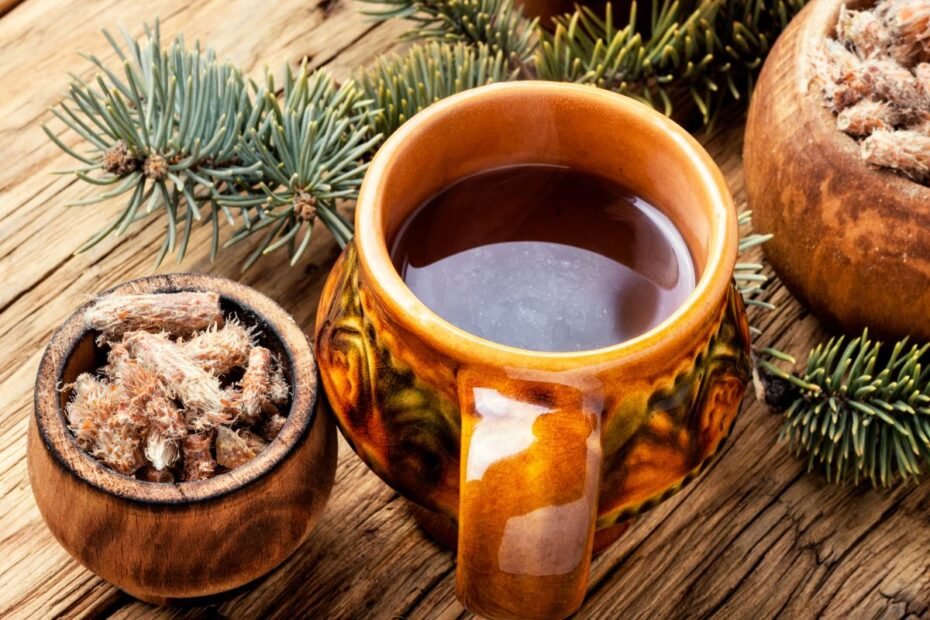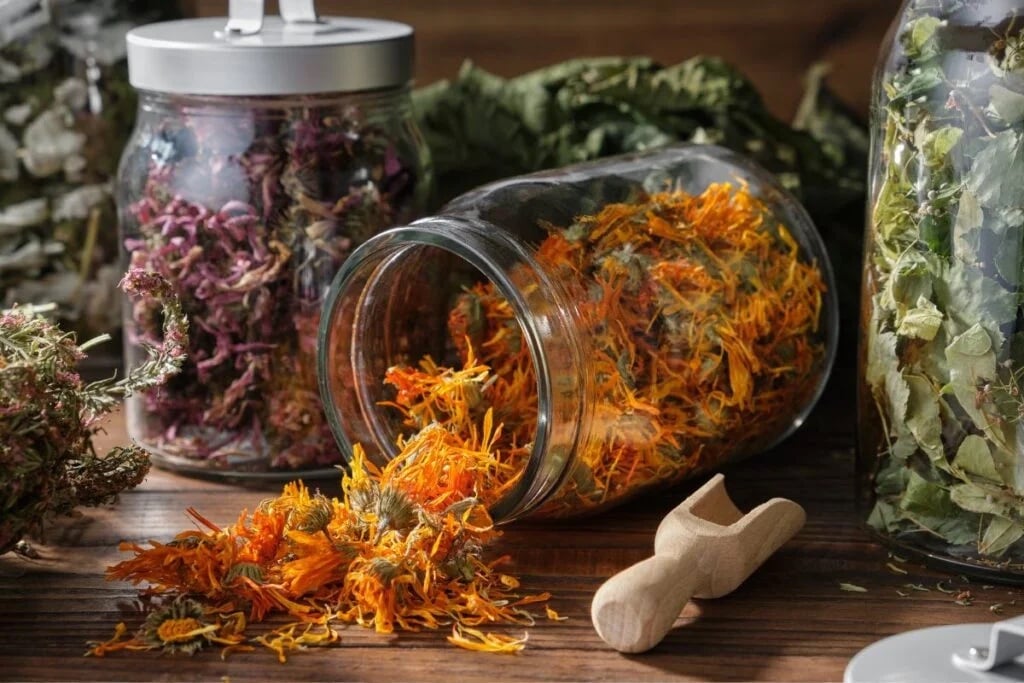Our bodies need essential vitamins and nutrients, which we obtain from entirely unexpected sources—for example, pine trees. People prepared health-promoting pine tea from these globally widespread plants for centuries. They used cones, buds, and pine needles for wellness purposes. A significant advantage is making fresh pine needle tea in any season. This is likely one of the rarer cases in many northern regions where fresh ingredients for tea can be harvested even in winter. So, let’s explore pine needle tea benefits and other pine tea beverages from buds or cones.
The pine tree (Pinus) belongs to the class Pinopsida and the family Pinaceae. Approximately 110 pine species are known worldwide. These trees are most widespread in the Northern Hemisphere, particularly in temperate climate zones.
Pines are evergreen coniferous plants. Depending on the species, they grow from 3 to 80 meters. They can be tall-trunked or low-growing, resembling shrubs.
Europe’s natural environment hosts one native species—the Scots pine (Pinus sylvestris). This pine species is the most widely distributed coniferous tree globally (after the common juniper). The Scots pine grows to 25–40 meters in height, with trunks exceeding 1.5 meters in diameter.
Medicinal Pine Raw Material—Easy to Harvest Yourself
A walk in a pine forest is a pleasant way to spend time and is also highly beneficial for our health and well-being. You may double this benefit — you can collect medicinal pine raw materials while walking.
It’s important to note that not all pine species are suitable for making tea, so avoid decorative or hybrid varieties of pine. Globally, the most commonly retrieved species for tea are lodgepole pine (Pinus contorta), ponderosa pine (Pinus ponderosa), and whitebark pine (Pinus albicaulis). However, people in Europe use needles and buds of Scots pine (Pinus sylvestris).
You shall collect medicinal pine materials in a clean forest, far from highways, residential areas, and industrial sites.

Harvesting and Preparing Pine Buds
- Early spring — March — is the perfect time to collect pine buds.
- When collecting pine buds, remember to wear gloves — fresh pine resin is very sticky and difficult to wash off your hands.
- For the best results, pick pine buds on a cloudy but dry day. At that moment the buds contain the highest resin concentration and valuable active substances.
- The most prized pine buds are those that have not yet opened. Once they begin to unfold, they gradually lose their beneficial properties.
- Use a sharp tool to cut the buds from the side branches of the pine tree. Avoid cutting the topmost shoots — this could harm the tree’s growth.
You should dry pine buds immediately after harvesting. The best way to dry them is naturally — at room temperature, in a well-ventilated space, away from direct sunlight.
Avoid using ovens and dryers or placing the buds near heating devices — this will destroy their valuable properties.
Natural drying takes about two weeks. You’ll know the buds are fully dry when they no longer feel moist when squeezed.
Store the dried pine buds in a paper bag in a dark, dry place. Properly dried and stored pine buds retain their beneficial properties for up to two years.
If your stock is older than that, it’s better to discard it and head back to the forest for a fresh harvest!
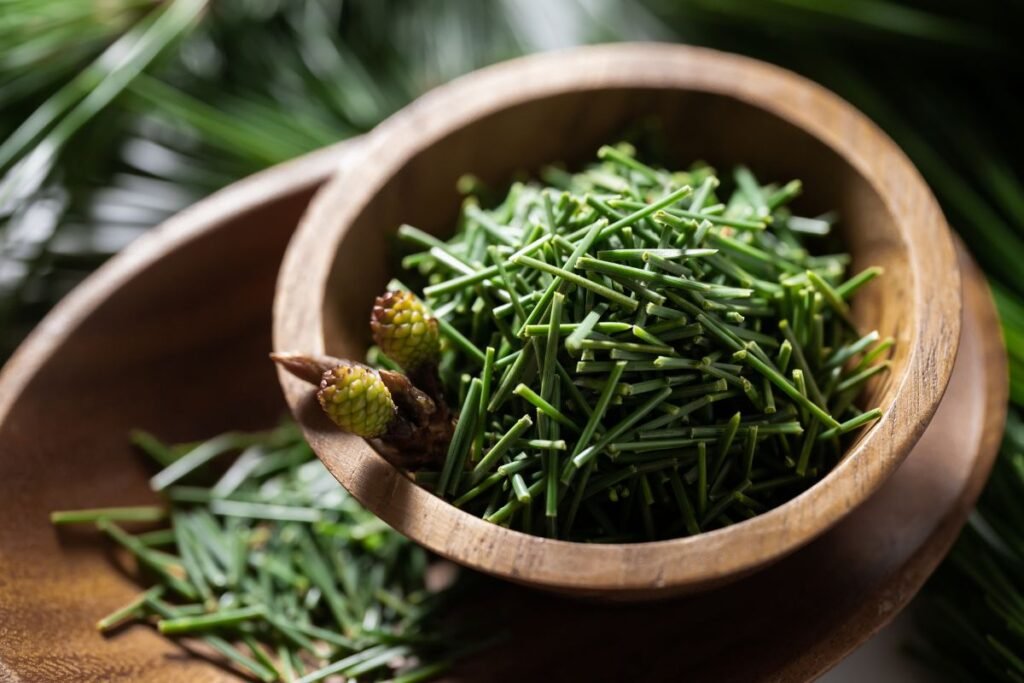
Harvesting Material for Pine Needle Tea
- Pine needles are most valuable during winter. Collect them from December to February.
- Cut pine branch tips with needles. After bringing them home, detach the needles and trim their tips (if the needles are very long, cut them into 2 cm strips).
- If harvesting from a young pine tree, use the needle tips. If collecting from a mature tree, take the portion of needles closer to the branch.
- You can try grinding needles into a concentrated powder.
Fresh pine needles retain the highest nutritional value. Store them in a linen or paper bag in the refrigerator. Pine needles preserve their beneficial vitamins and active compounds in cold for up to three months.
Pine needles can be dried naturally. Spread them in a thin layer at room temperature in a location shielded from direct sunlight.
Dried needles remain usable for one year. Mix dried pine needles with other medicinal herbs, such as raspberry leaves or thyme. You can combine pine, spruce, or juniper needles for coniferous tea.

Pine Tea Benefits from Buds
- Pine buds boast a rich and diverse composition of beneficial compounds. They contain vitamins A, B, and C, resins, essential oils, tannins, phytoncides (antibacterial agents), and oleic acid with antioxidant properties.
- Pine buds exhibit strong antiseptic and anti-inflammatory effects. Tea made from pine buds helps reduce fever, aids recovery, soothes throat and respiratory tract inflammation, and combats viruses and microbes. Experts recommend this tea for bronchitis, pneumonia, and tuberculosis.
- Pine buds have diuretic properties. This tea from buds assists in eliminating excess fluids from the body and stimulates bile secretion.
- Pine buds possess hemostatic (bleeding-stopping) properties. Their decoctions improve blood circulation, purify blood, and enhance brain function.
- This tea also has disinfection features for skin and mucosal injuries, suppresses bacterial inflammation, and accelerates wound healing.
- Pine bud tea alleviates the discomfort of oral mucosa damage or inflammation. It is suitable for gargling to treat gingivitis, stomatitis, and sore throat, and as a preventive measure against dental caries.
- Consuming pine bud tea can improve health conditions linked to vitamin deficiencies. It also alleviates symptoms of migraines, insomnia, and anxiety.
Pine Needle Tea Benefits
The primary beneficial nutrient in pine needles is vitamin C, one of the most potent antioxidants that strengthens immunity and neutralizes free radicals.
Pine needles also contain flavonoids (which fortify cells), amino acids like arginine and proline (vital for protein synthesis), and other health-supporting compounds.
Pine needle tea is an excellent immunity booster, which effectively treats and prevents scurvy.

How to Prepare Pine Bud Tea
Pine bud tea has an herbal flavor and the aroma of evergreen trees. You can consume it daily for therapeutic purposes—three times a day, one cup at a time—until your condition improves.
Ingredients for Pine Bud Tea:
- About 0.5 teaspoons of dried pine buds
- 200 ml of water
Place the pine buds in a tea-making vessel and pour boiling water over them. Cover the dish and let it steep for 10 minutes. Strain the tea before drinking.
How to Prepare Pine Needle Tea
People usually drink pine needle tea brewed hot, but a ‘cold option’ is also available. Pine needle tea from dried material has a bitter and astringent taste with a hint of minty undertones. This tea pairs well with honey for added sweetness.
Ingredients for Pine Needle Tea:
- 1–2 teaspoons of pine needles
- 200–300 ml of water
Place the pine needles in a tea-making vessel and pour boiled water (approximately 90°C) over them. Cover the utensil, steep for 10–20 minutes, and strain.
Herbalists advise against drinking this tea on an empty stomach, especially if you have high stomach acidity, as it may increase it further.
Drink pine needle tea for 7 days, followed by a 3-day break for general health maintenance. If your target is to prevent strengthening, drink 1–2 cups/day. However, during illness—such as colds, flu, or other acute conditions—you can drink 3 to 6 cups per day as part of your treatment plan.
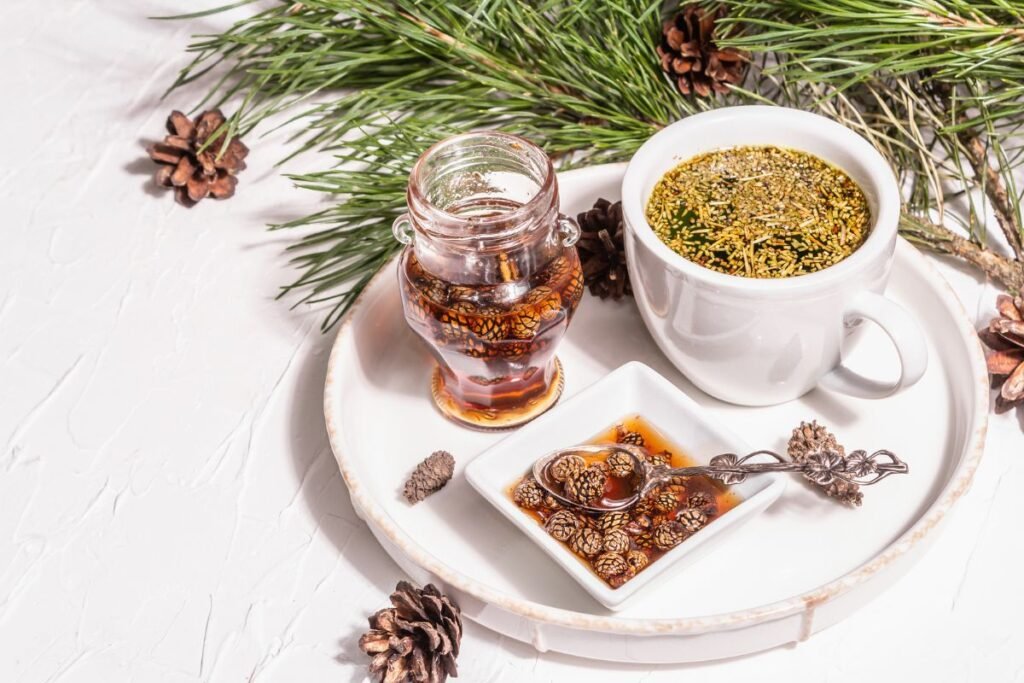
Pine Bud Tincture (Alcohol-Based)
Pine bud tincture with alcohol is effective for conditions such as radiculitis, arthritis, rheumatism, and urinary tract inflammation.
Ingredients:
- 0.5 liters of dried pine buds
- 0.5 liters of pure alcohol or high-quality vodka
Place the pine buds in a jar and pour alcohol over them. Seal the jar tightly and store it in a dark place for 12 days. Afterward, strain the tincture and transfer it to a clean, airtight glass bottle.
Usage Instructions:
Take the tincture on an empty stomach four times/day at a dose of 20 drops per serving. You should not use it for more than two weeks. Additionally, apply the tincture externally to rub sore joints or disinfect skin injuries.
Pine Bud Decoction
A pine bud decoction is highly effective for treating colds, inflammation, and throat and oral mucosa diseases.
Ingredients:
- 1 heaping tablespoon of dried pine buds
- 500 ml of water
Place finely chopped pine buds into a pot, add water, and boil for 15 minutes. Then, turn off the heat and let the covered pot sit for another 30 minutes. Strain the decoction and pour it into a clean, sealable jar.
Usage Instructions:
Consume the decoction at 2 tablespoons three times a day. You should not exceed the recommended dosage to avoid potential harm.
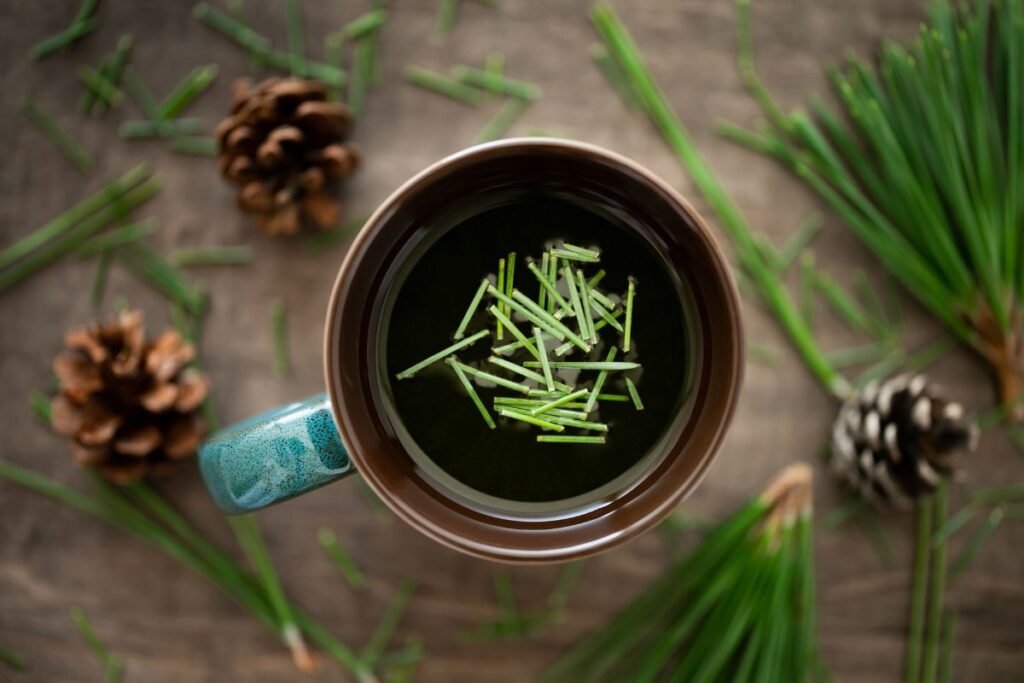
Pine Bud Syrup
Pine bud syrup is effective for treating coughs.
Ingredients for Pine Bud Syrup:
- 2 cups of dried pine buds
- 2 liters of water
- 1 kg of cane sugar
- 1 tablespoon of lemon juice
Preparation:
- Place the pine buds in a pot and pour in the water.
- Simmer on low heat until about half of the water has evaporated.
- Remove the pot from the heat, mash the pine buds, and strain the mixture through cheesecloth to extract the liquid.
- Add sugar to the liquid and cook on low heat, stirring, until the mixture thickens.
- Before finishing, add lemon juice and mix well.
Usage:
Consume the syrup when experiencing a cold or cough or as a preventive measure during the colder months.

Pine Bud Water
Pine bud water can help strengthen the body after illness or other causes of weakness.
Ingredients for Pine Bud Water:
- 2–3 handfuls of fresh pine buds
- 3–4 tablespoons of sugar
- 3 liters of water
Preparation:
- Place the pine buds in a jar, add sugar, and pour in cold filtered water.
- Seal the jar tightly and let it sit for 3–4 days before drinking. Store the water in the refrigerator for freshness.
Usage:
Drink one glass per day, divided into smaller portions throughout the day.
Pine Cone Tea
Have you ever tried pine cone tea? It’s an invigorating tea that quenches thirst and restores strength! Pine cone tea has a pleasant coniferous aroma and an unusual, specific taste that not everyone likes. This tea taste has a distinct woody aftertaste. Pine cones, like buds and needles, also contain various beneficial substances that help maintain health.
Collect young, fully unripe pine cones and diversify your diet with this easy-to-prepare tea. You will need:
- 75 g pine cones
- 200 ml water
Rinse the pine cones thoroughly under running water and pat them dry with a towel. Then, grind or chop them with a knife. Pour the prepared raw material into a teapot and fill it with boiling water. Then, cover the teapot or wrap it with a towel and let it steep for about 25 minutes. Strain the prepared tea and enjoy.
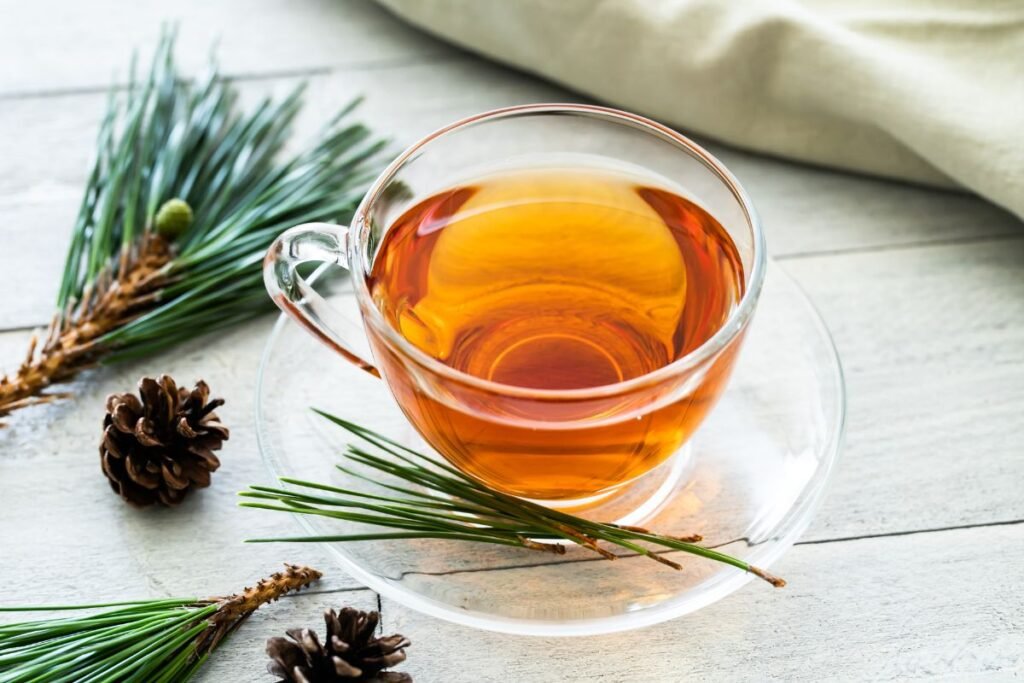
Side Effects of Pine Needle Tea and Preparations
Drinking pine needle tea is generally safe. Its side effects are rare and minor.
You should be more cautious when consuming pine bud tea. In some cases, it can even cause serious health problems.
- Overdosing in pine bud tea can cause migraines, cardiac arrhythmia, and digestive disorders.
- It is not recommended for pregnant women to drink pine bud tea. In this case, the potential harm outweighs the expected benefits.
- The high amount of tannins in pine buds increases blood clotting. They can increase the risk of blood clot formation.
- It is not advisable to drink pine bud tea if you have heart failure, hypotension (low blood pressure), severe hepatitis, severe kidney disease, gastritis, stomach ulcers, or acute pancreatitis.
- Pine bud tea is not recommended for children under 7 years old. Older children should drink this tea in smaller doses than adults.
Sources:
- https://www.webmd.com/diet/what-to-know-pine-needle-tea
- https://herbalhealthhut.com/herbal-tea/benefits-of-pine-needle-tea/
- https://garden.decorexpro.com/en/sad-i-ogorod/derevo/pochki-sosny.html
Associative photos © Canva.
